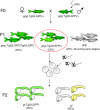Zebrafish as a model for normal and malignant hematopoiesis
- PMID: 21708900
- PMCID: PMC3124047
- DOI: 10.1242/dmm.006791
Zebrafish as a model for normal and malignant hematopoiesis
Abstract
Zebrafish studies in the past two decades have made major contributions to our understanding of hematopoiesis and its associated disorders. The zebrafish has proven to be a powerful organism for studies in this area owing to its amenability to large-scale genetic and chemical screening. In addition, the externally fertilized and transparent embryos allow convenient genetic manipulation and in vivo imaging of normal and aberrant hematopoiesis. This review discusses available methods for studying hematopoiesis in zebrafish, summarizes key recent advances in this area, and highlights the current and potential contributions of zebrafish to the discovery and development of drugs to treat human blood disorders.
Figures


References
-
- Bertrand J. Y., Traver D. (2009). Hematopoietic cell development in the zebrafish embryo. Curr. Opin. Hematol. 16, 243–248 - PubMed
Publication types
MeSH terms
Grants and funding
LinkOut - more resources
Full Text Sources
Medical
Miscellaneous

